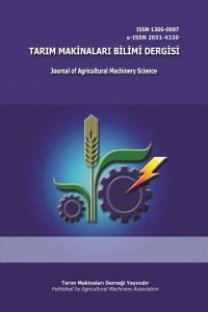Fuzzy Logic Based Ventilation for Controlling Harmful Gases in Livestock Houses
Air quality, fuzzy logic model, livestock housing
___
- Burmeister, A., M., 1986. Jurkschat, M. Nichelmann. Influence of stocking density on the heat balance in the domestic fowl (Gallus domesticus). Journal of Thermal Biology, vol. 11, pp. 117-120.
- Charles, D. R., 1984. A model of egg production. British Poultry Science, vol. 25, pp. 309-321.
- CIGR, 1984. Climatisation of animal houses. Report of working group, Scottish Farm Building Investigation Unit, Craibstone, Aberdeen, Scotland.
- Donham, K. J., D. Cumro, S. J. Reynolds and J. A. Merchant, 2000. Dose-response relationships between occupational aerosol exposures and cross-shift declines of lung function in poultry workers: recommendations for exposure limits, J. Occup. Environ. Med. Vol. 42, pp. 260-269.
- Gay, S. W., 2009. Ammonia Emissions and Animal Agriculture. Virginia Cooperative Extension. Puplication 442-110. Biological Systems Engineering College of Agriculture and Life Sciences, Virginia Polytechnic Institute and State University, Virginia State, Petersburg, USA.
- Henken, A. M., H. A. Brandsma, W. V. D. and Hel, M. W. A., 1991. Verstegen, Heat balance characteristics of limit-fed growing pigs of several breeds kept in groups at and below thermal neutrality. Journal of Animal Science vol. 69, pp. 2434-2442.
- Issley, S. S., E. Lang, 2015. Subject: Ammonia toxicity. https://emedicine.medscape.com/article/820298-overview (Online: June 2017)
- Macleod, M. G., 1984. Factors influencing the agreement between thermal physiology measurements and field performance in poultry. Archive of Experimental Veterinary Medicine, vol. 38, pp. 399-410.
- Mamdani, E. H., S. Assilion, 1974. An Experiment in Linguistic Synthesis with a Fuzzy Logic Controller", Intl J. Man-Machine Stud. Vol.7, pp. 1-13.
- Mendel, J., 1995. Fuzzy logic systems for engineering: a tutorial", Proceedings of the IEEE, vol. 83(3), pp. 345-377. Merchant, J. A., J. Kline, K. J. Donham, D. S. Bundy, and C. J. Hodne, 2003. Human health effects. In Iowa concentrated animal feeding operation air quality study. University of Iowa, Ames, Iowa. pp. 121-145.
- Wang, H. O., K. Tanaka, and M. F. Griffin, 1996. An approach to fuzzy control of nonlinear systems: Stability and design issues, IEEE Trans. Fuzzy Syst., vol. 4, pp. 14-23.
- Webster, A. J. F., 1981. Optimal housing criteria for ruminants. In: Environmental Aspects of Housing for Animal Production, Clark J A (ed.), London: Butterworths, pp. 217-232.
- ISSN: 1306-0007
- Yayın Aralığı: 4
- Başlangıç: 2005
- Yayıncı: Tarım Makinaları Derneği
Zeynep DUMANOĞLU, Bülent ÇAKMAK
Fuzzy Logic Based Ventilation for Controlling Harmful Gases in Livestock Houses
Nuri CAGLAYAN, Huseyin Kursat CELIK, Allan RENNIE
Determining the Droplet Size Classification of Hollow Cone Nozzles with Droplet Image Analysis
Design and Development of an Universal Vacuum Disc Equipped with Hole Adaptors for Precision Seeders
Dilara ERDOĞAN, Adnan DEĞİRMENCİOĞLU, Bülent ÇAKMAK, , Arzu YAZGI
Ahmet ÇIKMAN, Tali MONİS, A. Suat NACAR, Yasemin VURARAK
Comparison of Technical Specifications and Performances of Wind Machines
Çağdaş CİVELEK, Ali BAYAT, Mustafa ŞEHRİ
